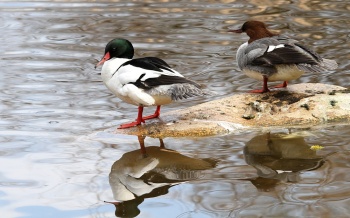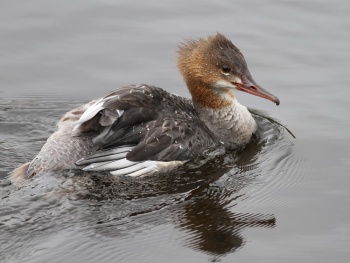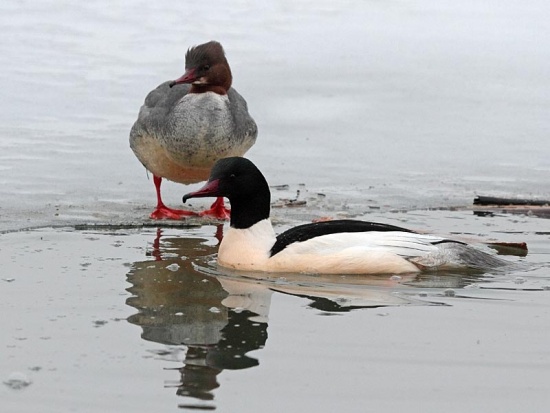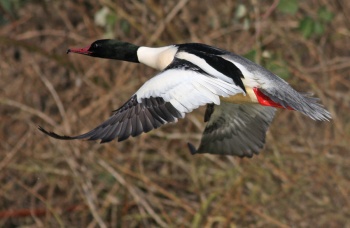(Additional video link. References updated) |
(Amended usertemplate for deceased member. C/right. References updated) |
||
| Line 1: | Line 1: | ||
| + | [[Image:Goosander pair by Macswede.jpg|thumb|550px|right|Goosander ''M. m. merganser'', male and female<br />Photo © by {{user|Macswede|Macswede}}<br />Råstasjön, Stockholm, [[Sweden]], March 2011]] | ||
'''Alternative name: Goosander''' | '''Alternative name: Goosander''' | ||
| − | + | ||
;[[:Category:Mergus|Mergus]] merganser | ;[[:Category:Mergus|Mergus]] merganser | ||
==Identification== | ==Identification== | ||
| − | [[Image:Common Merganser pair by eastwood.jpg|thumb|350px|right|Common Merganser ''M. m. americanus'', male and female. Note black bar on white wing coverts.<br />Photo by {{user|eastwood|eastwood}}<br />Vancouver, British Columbia, Canada, April 2011]] | + | [[Image:Common Merganser pair by eastwood.jpg|thumb|350px|right|Common Merganser ''M. m. americanus'', male and female. Note black bar on white wing coverts.<br />Photo © by {{user|eastwood|eastwood}}<br />Vancouver, British Columbia, Canada, April 2011]] |
'''Adult Male''' | '''Adult Male''' | ||
*Greenish-black head and upper neck | *Greenish-black head and upper neck | ||
| Line 17: | Line 18: | ||
'''Juvenile''' | '''Juvenile''' | ||
*Similar to adult female, but with white spot or line on lores, giving a 'striped' effect to the face. | *Similar to adult female, but with white spot or line on lores, giving a 'striped' effect to the face. | ||
| − | [[Image:Goosander juvenile by IanF.jpg|thumb|350px|right|Goosander ''M. m. merganser'', juvenile. Note white lores.<br />Photo by {{user|IanF|IanF}}<br />Dumfries, Dumfries & Galloway, Scotland, September 2011]] | + | [[Image:Goosander juvenile by IanF.jpg|thumb|350px|right|Goosander ''M. m. merganser'', juvenile. Note white lores.<br />Photo © by {{user|IanF|IanF}}<br />Dumfries, Dumfries & Galloway, Scotland, September 2011]] |
====Similar Species==== | ====Similar Species==== | ||
Female may be confused with female [[Red-breasted Merganser]], but shows a distinct division between head and chest. Crest is also less shaggy than in female Red-breasted, and the bill distinctly slenderer. | Female may be confused with female [[Red-breasted Merganser]], but shows a distinct division between head and chest. Crest is also less shaggy than in female Red-breasted, and the bill distinctly slenderer. | ||
| Line 23: | Line 24: | ||
===Breeding=== | ===Breeding=== | ||
====[[Europe]]==== | ====[[Europe]]==== | ||
| + | [[Image:Goosander pink male by Macswede.jpg|thumb|350px|right|Goosander ''M. m. merganser'', male. Some individuals can be intensely salmon-pink, likely diet-related<br />Photo © by {{user|Macswede|Macswede}}<br />Stockholm, [[Sweden]], January 2011]] | ||
Breeds in [[Iceland]] and north and west [[Britain]], throughout [[Scandinavia]] and across northern Europe from [[Poland]] eastwards. Breeding range slowly expanding west and south in Europe, reaching [[Germany]] and the [[Alps]] over the last 150 years, [[Scotland]] in 1871, northern [[England]] in 1941, [[Wales]] and [[Ireland]] in 1970, and a recent colonist in the [[Netherlands]] (where first bred in 1996), the [[Czech Republic]], and northern [[Greece]] at Lake Prespa. | Breeds in [[Iceland]] and north and west [[Britain]], throughout [[Scandinavia]] and across northern Europe from [[Poland]] eastwards. Breeding range slowly expanding west and south in Europe, reaching [[Germany]] and the [[Alps]] over the last 150 years, [[Scotland]] in 1871, northern [[England]] in 1941, [[Wales]] and [[Ireland]] in 1970, and a recent colonist in the [[Netherlands]] (where first bred in 1996), the [[Czech Republic]], and northern [[Greece]] at Lake Prespa. | ||
====[[Asia]]==== | ====[[Asia]]==== | ||
| Line 36: | Line 38: | ||
Vagrant to [[Greenland]], the [[Faroes]] and [[Svalbard]] and south to [[Portugal]] and [[Spain]], the Mediterranean islands, north [[Africa]] and [[Israel]], also recorded on [[Bermuda]]. | Vagrant to [[Greenland]], the [[Faroes]] and [[Svalbard]] and south to [[Portugal]] and [[Spain]], the Mediterranean islands, north [[Africa]] and [[Israel]], also recorded on [[Bermuda]]. | ||
==Taxonomy== | ==Taxonomy== | ||
| − | [[Image:Goosander male by Mahsleb.jpg|thumb|350px|right|Goosander ''M. m. merganser'', male in flight. Inner wing white, with no black covert bar.<br />Photo by | + | [[Image:Goosander male by Mahsleb.jpg|thumb|350px|right|Goosander ''M. m. merganser'', male in flight. Inner wing white, with no black covert bar.<br />Photo © by the late '''[https://www.birdforum.net/gallery/showgallery.php/ppuser/50827/cat/500 Mahsleb]'''<br />Colchester, [[England]], February 2009]] |
====Subspecies==== | ====Subspecies==== | ||
There are three subspecies<sup>[[#References|[1]]]</sup>: | There are three subspecies<sup>[[#References|[1]]]</sup>: | ||
| Line 48: | Line 50: | ||
==Habitat== | ==Habitat== | ||
| − | |||
Breeds along rivers and lakeshores in wooded areas, sometimes on moorland, on passage and in winter on large freshwaters, ofen reservoirs and gravel-pits, sometimes estuaries but rarely on the sea. | Breeds along rivers and lakeshores in wooded areas, sometimes on moorland, on passage and in winter on large freshwaters, ofen reservoirs and gravel-pits, sometimes estuaries but rarely on the sea. | ||
==Behaviour== | ==Behaviour== | ||
| Line 56: | Line 57: | ||
''[[Media:Mergus merganser (song).mp3|Listen in an external program]]'' | ''[[Media:Mergus merganser (song).mp3|Listen in an external program]]'' | ||
==References== | ==References== | ||
| − | #{{Ref- | + | #{{Ref-Clements6thAug17}}#[http://avibase.bsc-eoc.org/species.jsp?avibaseid=407E2CA886367DBB Avibase] |
{{ref}} | {{ref}} | ||
==External Links== | ==External Links== | ||
Revision as of 00:28, 2 July 2018
Alternative name: Goosander
- Mergus merganser
Identification

Photo © by eastwood
Vancouver, British Columbia, Canada, April 2011
Adult Male
- Greenish-black head and upper neck
- White breast, flanks and belly, often tinged salmon-pink.
- Black back and upperwing coverts; scapulars white with a narrow black edge.
- Secondaries white; secondary coverts all-white giving a fully white inner wing (Goosander M. m. merganser) or with dark tips making a dark bar across the white (Common Merganser M. m. americanus).
- Eclipse plumage from June-July to October-November similar to adult female.
Adult Female
- Red-brown head meets pale breast in crisp line of division.
- Well-defined white chin.
- White breast and belly grading to grey flanks.
- Pale grey body plumage.
Juvenile
- Similar to adult female, but with white spot or line on lores, giving a 'striped' effect to the face.

Photo © by IanF
Dumfries, Dumfries & Galloway, Scotland, September 2011
Similar Species
Female may be confused with female Red-breasted Merganser, but shows a distinct division between head and chest. Crest is also less shaggy than in female Red-breasted, and the bill distinctly slenderer.
Distribution
Breeding
Europe
Breeds in Iceland and north and west Britain, throughout Scandinavia and across northern Europe from Poland eastwards. Breeding range slowly expanding west and south in Europe, reaching Germany and the Alps over the last 150 years, Scotland in 1871, northern England in 1941, Wales and Ireland in 1970, and a recent colonist in the Netherlands (where first bred in 1996), the Czech Republic, and northern Greece at Lake Prespa.
Asia
Breeds across northern Asia to northern China, Sakhalin and occasionally Hokkaido, with a separate population on the Tibetan Plateau.
North America
Breeds in southeast Alaska and western Canada across the forest zone of central Canada and east to Newfoundland. In the USA breeds in the north-east and around the Great Lakes, and in the west range extends south to northern California, Arizona and New Mexico.
Northern populations are migratory, most others resident or partial migrants, moving to coastal areas close to breeding site. In winter found in southern Britain and northern France east to Poland and in coastal Norway and Sweden. Small numbers also winter in Central Europe, the northern Mediterranean and the Black and Caspian Seas. In the Far East winters from Japan southwards and in North America winters over much of the USA except the north-central states and the Gulf Coast.
Many, if not most, males in the European population leave the females to care for their ducklings in midsummer and fly north to the Varangerfjord in northeast Norway for moulting, before returning in late autumn.
Vagrant to Greenland, the Faroes and Svalbard and south to Portugal and Spain, the Mediterranean islands, north Africa and Israel, also recorded on Bermuda.
Taxonomy
Subspecies
There are three subspecies[1]:
- M. m. merganser (Goosander).
- M. m. comatus (Tibetan Goosander).
- Restricted to the Tibetan Plateau in central Asia. Slightly larger and finer-billed than M. m. merganser.
- M. m. americanus (Common Merganser).
- Breeds in North America. It has deeper base to bill and the male has dark bar across bases of median coverts.
- In the past, treated as a separate species Mergus americanus by the AOU until 1931, but this has not been recognised more recently by any of the main ornithological authorities[2].
Habitat
Breeds along rivers and lakeshores in wooded areas, sometimes on moorland, on passage and in winter on large freshwaters, ofen reservoirs and gravel-pits, sometimes estuaries but rarely on the sea.
Behaviour
The diet includes fish, mussels, shrimps, and aquatic insects.
Vocalisation
<flashmp3>Mergus merganser (song).mp3</flashmp3>
Listen in an external program
References
- Clements, J. F., T. S. Schulenberg, M. J. Iliff, D. Roberson, T. A. Fredericks, B. L. Sullivan, and C. L. Wood. 2017. The eBird/Clements checklist of birds of the world: v2017, with updates to August 2017. Downloaded from http://www.birds.cornell.edu/clementschecklist/download/
- Avibase
Recommended Citation
- BirdForum Opus contributors. (2024) Common Merganser. In: BirdForum, the forum for wild birds and birding. Retrieved 7 May 2024 from https://www.birdforum.net/opus/Common_Merganser
External Links






